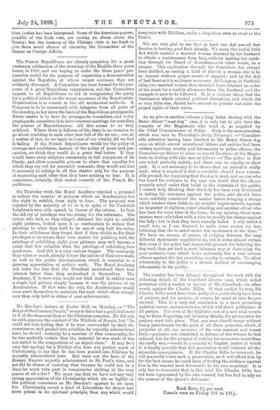On Thursday week, the Royal Academy rejected a proposal to
reduce the number of pictures which an Academician has the right to exhibit, from eight to four. The proposal was rejected by the majority of 14 to 9, in spite of Sir Frederick Leighton's very able speech in favour of the reform. In fact, the old cry of privilege was too strong for the reformers. The artists who had, as they alleged, obtained the right to exhibit eight pictures, looked upon it as confiscation to reduce that privilege to what they held to be one of only half the value. In their selfishness they forget that if they stickle so for their privileges as to reduce their own motive for painting well, the privilege of exhibiting eight poor pictures may well become a great deal less valuable than the privilege of exhibiting four good ones. And this is a very serious danger. The monopoly they value so much, already lowers the calibre of their own work, as well as the public discrimination which is essential to a growing appreciation of artistic work. The Royal Academy will learn too late that the President understood their true interest better than they understood it themselves. The Academy, if it were wise, would not bind itself to exhibit even a single bad picture simply because it was the picture of an Academician. If that were the rule, the Academicians would soon exert themselves to maintain the rank which often enough now they only hold in virtue of past achievements.


































 Previous page
Previous page